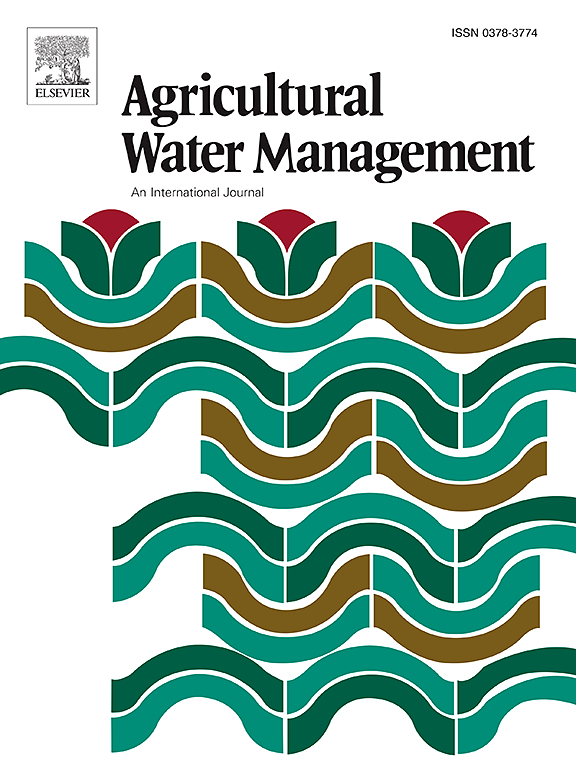从可持续农业的角度评价盐水灌溉对苜蓿生物量和质量的影响
IF 6.5
1区 农林科学
Q1 AGRONOMY
引用次数: 0
摘要
淡水资源的缺乏是干旱半干旱地区农作物生产的一个重要限制因素。盐水灌溉是解决淡水短缺的可行方案,特别是在华北平原,通过利用盐水资源来维持作物生产,同时通过季节性降雨淋滤减少土壤盐分积累。本研究评估了2022-2023年5个灌溉量(20-100 mm)下,5.0和7.6 dS/m的盐水灌溉对苜蓿生物量和质量的影响。结果表明,合理的盐水灌溉能显著提高苜蓿生物量和品质。灌水使前两次收获(H1, H2)生物量显著增加,后两次收获(H3, H4)生物量增加不明显。最大生物量达到60 mm (5.0 dS/m, 15.99 t/ha)和76 mm (7.6 dS/m, 14.71 t/ha),比雨养对照增加40.3% %和24.3% %。早季收获(H1-H2)生物量增加10-67 %,主要是通过茎的生长(贡献35-80 %)。灌水量为60 mm (5.0 dS/m)时,CP在H1显著增加,而盐度升高(7.6 dS/m)使ADF和NDF含量增加。盐水灌溉提高了土壤EC,而夏季降雨有效地浸出了盐分,使土壤盐度保持在0-40 cm以下,低于苜蓿耐受阈值。结构方程模型量化了关键相互作用:灌水量直接增加了生物量,同时提高了土壤EC,水盐度通过EC积累间接降低了产量。结果表明,5.0dS/m盐水的最佳灌水量为51.0 ~ 72.3 mm, 7.6dS/m盐水的最佳灌水量为58.3 ~ 76.0 mm,可平衡20 ~ 40% %的增产和稳定的年际土壤EC。本文章由计算机程序翻译,如有差异,请以英文原文为准。
Assessment of saline water irrigation on biomass and quality of alfalfa: A sustainable agriculture perspective
The lack of freshwater resources is a critical limiting factor for the crop production in the arid and semi-arid regions. Saline water irrigation presents a viable solution for addressing freshwater scarcity, particularly in North China Plain, by leveraging saline water resources to sustain crop production while minimizing soil salinity accumulation through seasonal rainfall leaching. This study assessed the effects of saline water irrigation (5.0 and 7.6 dS/m) on alfalfa biomass and quality across five irrigation amounts (20–100 mm) in 2022–2023. Results showed that reasonable saline water irrigation significantly enhanced alfalfa biomass and quality. Biomass increased markedly in the first two harvests (H1, H2) due to the irrigation but not in the latter two (H3, H4). The maximum biomass achieved at 60 mm (5.0 dS/m, 15.99 t/ha) and 76 mm (7.6 dS/m, 14.71 t/ha), representing 40.3 % and 24.3 % increases over rainfed controls. Early-season harvests (H1-H2) exhibited 10–67 % biomass enhancements primarily through stem growth (35–80 % contribution). CP was significantly increased at the H1 with irrigation of 60 mm (5.0 dS/m), whereas elevated salinity (7.6 dS/m) increased ADF and NDF content. Saline water irrigation elevated soil EC, while summer rainfall effectively leached salts, maintaining 0–40 cm soil salinity below alfalfa tolerance thresholds. Structural equation modeling quantified critical interactions: irrigation amount directly enhanced biomass while elevating soil EC, and water salinity indirectly reduced yield via EC accumulation. The optimal irrigation amounts were determined to be 51.0–72.3 mm for 5.0dS/m saline water and 58.3–76.0 mm for 7.6dS/m water, which balanced 20–40 % yield gains with stable interannual soil EC.
求助全文
通过发布文献求助,成功后即可免费获取论文全文。
去求助
来源期刊

Agricultural Water Management
农林科学-农艺学
CiteScore
12.10
自引率
14.90%
发文量
648
审稿时长
4.9 months
期刊介绍:
Agricultural Water Management publishes papers of international significance relating to the science, economics, and policy of agricultural water management. In all cases, manuscripts must address implications and provide insight regarding agricultural water management.
 求助内容:
求助内容: 应助结果提醒方式:
应助结果提醒方式:


